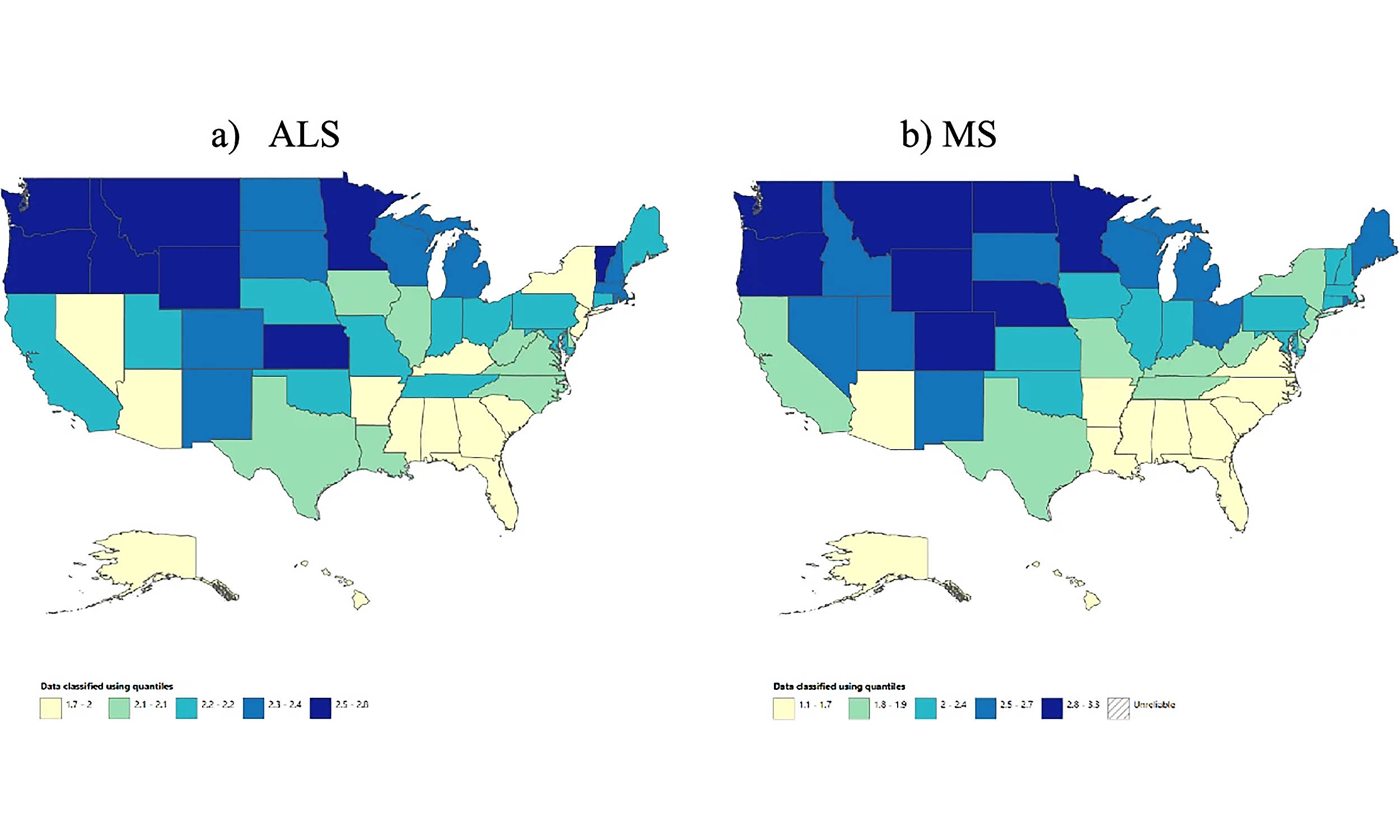Some diseases appear random until science looks closer. Patterns emerge, questions arise, and the search for hidden connections begins.
A recent study published in the journal Scientific Reports has done exactly that – uncovering a remarkable geographic relationship between amyotrophic lateral sclerosis (ALS) and multiple sclerosis (MS).
These two debilitating neurological conditions, long believed to be unrelated, now seem to share a powerful spatial link that could reshape how we think about their origins.
Geographic pattern for ALS
The research was led by Melissa Schilling, a professor at New York University’s Stern School of Business who specializes in analyzing large-scale datasets using econometrics.
“The results of the study are surprising because previous studies have typically concluded there was no evidence for a mechanistic or genetic link between the two diseases,” said Schilling.
By examining nationwide data, Schilling and her colleagues noticed overlapping geographic patterns for both ALS and MS in the United States.
Even after adjusting for race, gender, wealth, latitude, and access to neurological healthcare, the correlation remained extremely high.
The findings suggest that both diseases may share a hidden environmental or social factor influencing where they occur.
Heat maps make patterns clear
Heat maps from the research make the connection visible. According to the study, the patterns of ALS and MS line up across several regions, showing remarkable similarities.
This visual evidence adds strength to the statistical findings. It indicates that certain regions face higher risks for both diseases, pointing to something deeper than coincidence.
Until now, researchers focused mainly on biological and genetic causes of ALS and MS. This study, however, shifts attention toward geography – toward where people live and the shared features of those places.
The research challenges scientists to look beyond the lab and consider the world around us.
The deceptive role of gender
The researchers also discovered why this link escaped detection for so long. The answer lies in a statistical quirk called Simpson’s paradox.
This phenomenon occurs when a trend appears within individual groups but vanishes or reverses when those groups are combined.
In this study, gender played that deceptive role. When data were separated by gender, both sexes showed more than a 70 percent correlation between ALS and MS in their geographic distribution.
Yet when combined, the trend disappeared because ALS tends to affect men more, while MS is more common among women.
This discovery reveals how subtle data interactions can mask major health insights. Without separating the genders, the relationship between ALS and MS might have remained buried under misleading averages.
Strong geographic pattern for ALS
For decades, scientists have known that MS is more common in northern regions. Many linked this to sunlight exposure, UV radiation, and vitamin D levels.
Researchers even tried treating patients with vitamin D or UV light, hoping to reduce symptoms or prevent disease. Yet results were inconsistent or minimal.
The new study questions that long-standing theory. Instead, it shows that MS and ALS have a stronger geographic bond with each other than with latitude alone.
This means both diseases could share an environmental factor that varies across regions but not perfectly with latitude.
“I started gathering and analyzing every dataset I could find relevant to ALS about nine years ago, when a friend with ALS asked me if I would take a look at the data,” said Schilling.
“I was very surprised to find such a strong geographic pattern as most of the research on ALS does not emphasize the role of geography. I was even more surprised to find that ALS has a very strong association with the geography of MS.”
Identifying the environmental factors
According to Schilling, the finding is important because it suggests that an environmental factor likely plays a significant role in both diseases, and that could provide clues that help determine causes, prevention, and treatment.
What could that environmental factor be? The possibilities are wide-ranging. They include natural influences like viruses, parasites, algae, and molds.
Factors may also involve human activities such as farming methods, mining, industrial pollution, and chemical contamination of fisheries. Even heating oil use could play a role.
“The list of suspects is long, but comparing across geographies and, in particular, across outlier locations, such as the Faroe Islands, where MS increased strikingly after military troops arrived there in the 1940s, could significantly narrow the hunt,” said Schilling.
These insights remind researchers that the environment remains one of the least understood but most powerful influences on human health.
Identifying the right culprit among so many candidates will require careful, cross-regional comparisons and global cooperation.
Broad analysis strengthens results
The study extended beyond the United States. To ensure accuracy, Schilling’s team replicated the analysis worldwide.
The researchers combined data from the U.S. Centers for Disease Control and Prevention with global mortality statistics from the World Health Organization.
The results remained consistent: ALS and MS share a strong geographic association across continents.
Such replication strengthens confidence in the finding. It suggests that this relationship is not unique to one country or culture but may reflect a universal environmental factor influencing both diseases.
Connecting geography to ALS
These discoveries open a new chapter in the study of neurological disease. If environmental elements play a key role in both ALS and MS, then prevention strategies could one day become possible.
Researchers might identify chemical exposures, pathogens, or lifestyle factors contributing to disease patterns and reduce them before they cause harm.
By connecting geography to biology, this study challenges scientists to rethink old assumptions. It blends epidemiology, data science, and environmental research into a single compelling narrative.
As researchers continue to explore these patterns, they may not only understand these diseases better but also uncover new ways to protect future generations.
In the end, the message is simple yet profound: the world we live in may shape our health in more ways than we ever imagined.
The study is published in the journal Scientific Reports.
—–
Like what you read? Subscribe to our newsletter for engaging articles, exclusive content, and the latest updates.
Check us out on EarthSnap, a free app brought to you by Eric Ralls and Earth.com.
—–
First Appeared on
Source link












